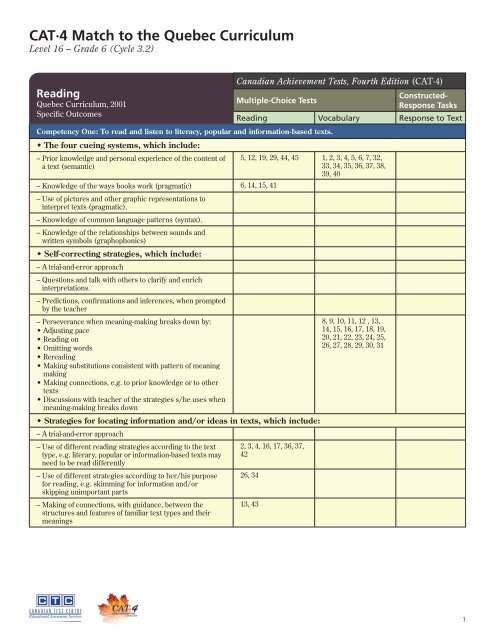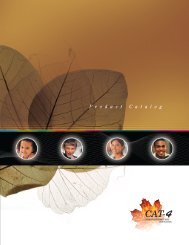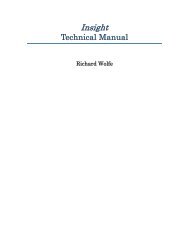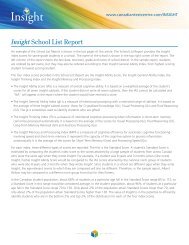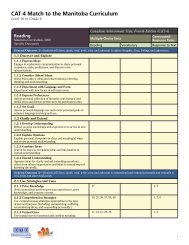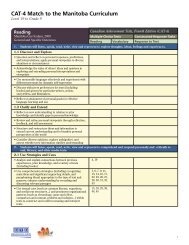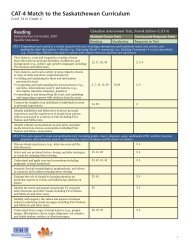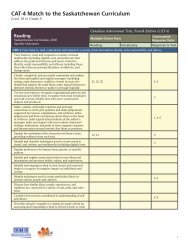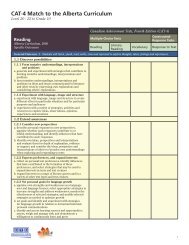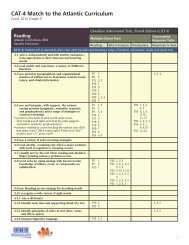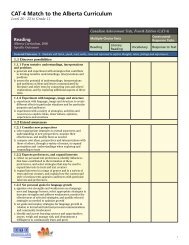CATâ4 Match to the Quebec Curriculum - Canadian Test Centre
CATâ4 Match to the Quebec Curriculum - Canadian Test Centre
CATâ4 Match to the Quebec Curriculum - Canadian Test Centre
Create successful ePaper yourself
Turn your PDF publications into a flip-book with our unique Google optimized e-Paper software.
CAT∙4 <strong>Match</strong> <strong>to</strong> <strong>the</strong> <strong>Quebec</strong> <strong>Curriculum</strong>Level 16 – Grade 6 (Cycle 3.2)Reading<strong>Quebec</strong> <strong>Curriculum</strong>, 2001Specific Outcomes<strong>Canadian</strong> Achievement <strong>Test</strong>s, Fourth Edition (CAT·4)Multiple-Choice <strong>Test</strong>sCompetency One: To read and listen <strong>to</strong> literacy, popular and information-based texts.• The four cueing systems, which include:– Prior knowledge and personal experience of <strong>the</strong> content ofa text (semantic)– Knowledge of <strong>the</strong> ways books work (pragmatic) 6, 14, 15, 41– Use of pictures and o<strong>the</strong>r graphic representations <strong>to</strong>interpret texts (pragmatic).– Knowledge of common language patterns (syntax).– Knowledge of <strong>the</strong> relationships between sounds andwritten symbols (graphophonics)• Self-correcting strategies, which include:– A trial-and-error approach– Questions and talk with o<strong>the</strong>rs <strong>to</strong> clarify and enrichinterpretations.– Predictions, confirmations and inferences, when promptedby <strong>the</strong> teacher– Perseverance when meaning-making breaks down by:• Adjusting pace• Reading on• Omitting words• Rereading• Making substitutions consistent with pattern of meaningmaking• Making connections, e.g. <strong>to</strong> prior knowledge or <strong>to</strong> o<strong>the</strong>rtexts• Discussions with teacher of <strong>the</strong> strategies s/he uses whenmeaning-making breaks downConstructed-Response TasksReading Vocabulary Response <strong>to</strong> Text5, 12, 19, 29, 44, 45 1, 2, 3, 4, 5, 6, 7, 32,33, 34, 35, 36, 37, 38,39, 40• Strategies for locating information and/or ideas in texts, which include:– A trial-and-error approach– Use of different reading strategies according <strong>to</strong> <strong>the</strong> texttype, e.g. literary, popular or information-based texts mayneed <strong>to</strong> be read differently– Use of different strategies according <strong>to</strong> her/his purposefor reading, e.g. skimming for information and/orskipping unimportant parts– Making of connections, with guidance, between <strong>the</strong>structures and features of familiar text types and <strong>the</strong>irmeanings2, 3, 4, 16, 17, 36, 37,4226, 3413, 438, 9, 10, 11, 12 , 13,14, 15, 16, 17, 18, 19,20, 21, 22, 23, 24, 25,26, 27, 28, 29, 30, 311
CAT∙4 <strong>Match</strong> <strong>to</strong> <strong>the</strong> <strong>Quebec</strong> <strong>Curriculum</strong>Level 16 – Grade 6 (Cycle 3.2)Reading<strong>Quebec</strong> <strong>Curriculum</strong>, 2001Specific Outcomes– Use of <strong>the</strong> following <strong>to</strong> locate specific information and/orideas• Pictures and o<strong>the</strong>r graphic representations in texts• Headings, chapter divisions• Table of contents• Index– Beginning <strong>to</strong> identify, with guidance, <strong>the</strong> stages ofresearching a <strong>to</strong>pic, which include:• developing research questions• narrowing a <strong>to</strong>pic• selecting and recording information from• reading/listening/viewing• categorizing information– Initial development of a personal method for researchinga <strong>to</strong>pic,• with guidance<strong>Canadian</strong> Achievement <strong>Test</strong>s, Fourth Edition (CAT·4)Multiple-Choice <strong>Test</strong>sConstructed-Response TasksReading Vocabulary Response <strong>to</strong> Text• Reading, listening <strong>to</strong> and viewing a range of self-selected and personally relevant texts that include:– Use of personal, social and cultural background andexperiences <strong>to</strong> interpret texts– Searching <strong>the</strong> Internet <strong>to</strong> locate texts that entertain,promote, and inform7, 8 1, 3, 4, 5• Developing a personal response process in <strong>the</strong> context of a community of readers through:– Discussion of responses with o<strong>the</strong>rs individually, in smallgroups and in <strong>the</strong> whole class.– Acknowledgment and support for different interpretationsfrom peers of one text– Discussion of favourite parts, ideas, and/or information intexts– Recount of <strong>the</strong> s<strong>to</strong>ry and, with guidance, outline ofinformation in a text– Development of opinions on literary or popular texts 3, 4, 5– Sharing of new or interesting information gained from atext– Sharing of responses with o<strong>the</strong>rs <strong>to</strong> clarify meaning andenrich interpretation– Participation in literature circles <strong>to</strong> discuss own ando<strong>the</strong>rs‘ responses <strong>to</strong> texts– Comparing own responses with those of o<strong>the</strong>rs at abeginner’s level– Discussing own response process at a beginner’s level• Moving beyond <strong>the</strong> initial response through:– Responses <strong>to</strong> texts in a variety of ways that include talking,writing, <strong>the</strong> Arts, media– Early attempts <strong>to</strong> explain own views of a text 1, 4, 51, 2, 61, 2, 3, 4, 5, 62
CAT∙4 <strong>Match</strong> <strong>to</strong> <strong>the</strong> <strong>Quebec</strong> <strong>Curriculum</strong>Level 16 – Grade 6 (Cycle 3.2)Reading<strong>Quebec</strong> <strong>Curriculum</strong>, 2001Specific Outcomes– Support for own views with references <strong>to</strong> <strong>the</strong> text in smalland large group discussions– Discussions of structures and features of text and <strong>the</strong>irimpact on <strong>the</strong> reader– Discussion of <strong>the</strong> structures and features of a text and<strong>the</strong>ir influence on <strong>the</strong> meaning of a text– Returning <strong>to</strong> a text <strong>to</strong> confirm interpretations andunderstandings in discussions with peers– Adjustment of own interpretations in <strong>the</strong> light of <strong>the</strong>responses of o<strong>the</strong>rs at a beginner’s level• Seeing a text as a construction through:– Suggestion of alternative endings or actions in a literary orpopular text– Plausibility of events, characters, opinions and/orinformation in a text in relation <strong>to</strong> own values andexperiences– Comparison of texts that are familiar by recognizing:• <strong>the</strong> same <strong>the</strong>me or idea developed in different ways in twoliterary or popular texts• that non-fiction texts on <strong>the</strong> same <strong>to</strong>pic contain differentinformation• cross-curricular connections between texts, e.g. treatmen<strong>to</strong>f a <strong>the</strong>me in a literary and in a his<strong>to</strong>ry text• identification of some of <strong>the</strong> ways in which information ispresented in popular and information-based texts<strong>Canadian</strong> Achievement <strong>Test</strong>s, Fourth Edition (CAT·4)Multiple-Choice <strong>Test</strong>sConstructed-Response TasksReading Vocabulary Response <strong>to</strong> Text11, 389, 27, 46 525, 39 1, 4, 5• Understanding <strong>the</strong> influence of familiar structures and features on <strong>the</strong> meaning of a text through:– Identification of some structures and features of familiartext types– Location of similar structures and features in o<strong>the</strong>r textsof <strong>the</strong> same type– Knowledge of familiar text types transferred <strong>to</strong> ownwriting by using known structures and features• Beginning <strong>to</strong> identify <strong>the</strong> view of <strong>the</strong> world presented in a text through:– Teacher and peer discussions of <strong>the</strong> ways in whichdifferent groups of people are depicted in texts– Own questions about <strong>the</strong> view of <strong>the</strong> world represented in<strong>the</strong> text, with guidance from <strong>the</strong> teacher– Making of inferences, when prompted, about <strong>the</strong> view of<strong>the</strong> world presented by <strong>the</strong> text– Discussions, with guidance, of whose voices are heard andwhose are missing in a text– Comparison, with guidance, of own values with some of<strong>the</strong> social, cultural and his<strong>to</strong>rical values in a literary text inteacher and peer discussions2310, 18, 20, 22, 24, 30,31, 32, 40, 471, 3, 43
CAT∙4 <strong>Match</strong> <strong>to</strong> <strong>the</strong> <strong>Quebec</strong> <strong>Curriculum</strong>Level 16 – Grade 6 (Cycle 3.2)Reading<strong>Quebec</strong> <strong>Curriculum</strong>, 2001Specific OutcomesCompetency Three: To represent his/her literacy in different media<strong>Canadian</strong> Achievement <strong>Test</strong>s, Fourth Edition (CAT·4)Multiple-Choice <strong>Test</strong>s• The familiar images, signs, symbols and logos in her/his environment:– Recognition that <strong>the</strong>y are made by people for differentpurposes– Recognition that <strong>the</strong>y have meanings/messages– Identification of how <strong>the</strong>se images contribute <strong>to</strong> <strong>the</strong>messages/meanings of various media textsConstructed-Response TasksReading Vocabulary Response <strong>to</strong> Text• Use of reper<strong>to</strong>ire of strategies <strong>to</strong> unlock message(s)/meaning(s) in various media texts (See also Competency 1, ReadingStrategies):– Own questions in order <strong>to</strong> predict and confirm– Drawing on prior experience with familiar media texts <strong>to</strong>understand how <strong>the</strong>y are constructed– Rereading/looking again in order <strong>to</strong> clarify and extendunderstanding of a text, etc.– Use of reper<strong>to</strong>ire of communication strategies whenmeaning breaks down and/or <strong>to</strong> sustain meaning• Make meaning of a media text by:– Brains<strong>to</strong>rming– Drawing on prior knowledge– Sharing responses with peers– Making connections <strong>to</strong> own experiences– Returning <strong>to</strong> text– Considering some of <strong>the</strong> functions of different, familiarmedia in relation <strong>to</strong> her/his understanding of <strong>the</strong>message(s)/meaning(s) of a text, i.e. entertainment,promotion and information– Using structures and features of <strong>the</strong> medium and text typein order <strong>to</strong> clarify meaning and explain her/his response,in collaboration with peers.– Confirming, in collaboration with peers and teacher,that a media text can contain more than one meaning ormessage– Identifying and discussing some of <strong>the</strong> ways in whichpictures, illustrations, popular symbols and signs andimages enhance <strong>the</strong> message(s)/meaning(s) in mediatexts designed for young viewers– Using text <strong>to</strong> support interpretation of characters’ pointsof view in narrative and popular texts– Responding <strong>to</strong> messages on <strong>the</strong> computer, e.g. multimediasoftware, E-mail48334
CAT∙4 <strong>Match</strong> <strong>to</strong> <strong>the</strong> <strong>Quebec</strong> <strong>Curriculum</strong>Level 16 – Grade 6 (Cycle 3.2)Writing<strong>Quebec</strong> <strong>Curriculum</strong>, 2001Specific Outcomes<strong>Canadian</strong> Achievement <strong>Test</strong>s, Fourth Edition (CAT·4)Multiple-Choice <strong>Test</strong>sWritingConventionsCompetency 2: To write self-expressive, narrative and information-based textsSpellingConstructed-Response TasksWritingThe student understands that writing is a communication system and assigns meaning <strong>to</strong> her/his texts by:• Self-selection of own <strong>to</strong>pics, structures and features,based on purpose and audience• Writing <strong>to</strong> a familiar audience (peers, family, trusted adults) in order <strong>to</strong> express meaning(s):– Pictures, symbols and/or signs integrated with print.– Identification of purpose for writing– Specific structures and features of familiar textsincorporated in<strong>to</strong> own writing• Using <strong>the</strong> linguistic structures and features of texts in own writing:– Experimentation with <strong>the</strong> register of a text in a relevantcontext or situation for a specific purpose and for afamiliar audience of peers, family and friends, e.g. in anote <strong>to</strong> a friend or a note <strong>to</strong> <strong>the</strong> principal, on a Web sites/he is creating, in a s<strong>to</strong>ry in <strong>the</strong> role of a familiar adult oryounger child– Reflection about strengths and learning goals throughwriting selections already accumulated in a portfolio– Syntactic structures that carry meaning: <strong>the</strong> structure of aquestion, a request, an apology– Selection of ways <strong>to</strong> influence a familiar audience inself-expressive and narrative texts, e.g. through wordchoices, such as using sound-words, such as swoosh; anappropriate register, such as friends talking <strong>to</strong>ge<strong>the</strong>r; andan appropriate syntax– Syntax that is chosen in order <strong>to</strong> add meaning <strong>to</strong> a text,given purpose, audience and context– Experimentation, at a beginner’s level, with differentsyntactic structures that are appropriate <strong>to</strong> purpose,audience and context– Some control of <strong>the</strong> following linguistic features: tenses,verb/subject agreement, voice, i.e. first, second, thirdperson– Adaptation of <strong>the</strong> structure and features of different texts<strong>to</strong> different requirements, given <strong>the</strong> context• Writing on a daily basis:– Own <strong>to</strong>pics and text types chosen <strong>to</strong> meet a specificpurpose, audience and context• Writing for specific purposes and in different contexts which include:– Getting things done– Personal needs– For pleasure– Clarifying thoughts1, 3, 4, 54, 51, 2, 3, 4, 53, 45
CAT∙4 <strong>Match</strong> <strong>to</strong> <strong>the</strong> <strong>Quebec</strong> <strong>Curriculum</strong>Level 16 – Grade 6 (Cycle 3.2)Writing<strong>Quebec</strong> <strong>Curriculum</strong>Specific Outcomes<strong>Canadian</strong> Achievement <strong>Test</strong>s, Fourth Edition (CAT·4)Multiple-Choice <strong>Test</strong>sWritingConventionsSpelling– Solving problems 3, 4– Expressing ideas and feelings 2, 5– Recording experiences 1– Developing and exploring new ideas and informationConstructed-Response TasksWritingExplora<strong>to</strong>ry prewriting activities appropriate <strong>to</strong> purpose, audience and context for <strong>the</strong> writing:– Brains<strong>to</strong>rming for information and asking questions– Drawing on ideas, prior experiences and personalmemories– Drawing, planning, talking– Reading, listening <strong>to</strong>, viewing and talking about s<strong>to</strong>ries,songs, poems and books– Using graphic organizers– Telling and retelling s<strong>to</strong>ries– Drawing on prior knowledge• Writing activities that nourish <strong>the</strong> development of a process for producing written texts:– Regular, sustained time <strong>to</strong> write on a daily basis– Drafts of own writing with focus on making meaning– Rereading of own writing with focus on meaning– Sharing own writing with peers– Seeking response <strong>to</strong> writing from peers and teacher– Selection of some pieces of writing <strong>to</strong> develop more fully,in collaboration with teacher– One or two strategies for crafting and revising ownwriting, on a trial-and-error basis:• Seeking feedback, rereading favourite texts <strong>to</strong> makediscoveries about what <strong>the</strong> author did• Questioning own texts as a writer, e.g. Does this leaddraw my readers in? Does <strong>the</strong> text say what I want it <strong>to</strong>say• Talking about personal revision process– Initial editing skills, with guidance from teacher and incollaboration with peers: understanding of how <strong>to</strong> find andcorrect a specified error; mini-lessons on areas in need ofreview; developing an editing checklist– Self-edits with focus on a limited number (1 or 2) ofwriting conventions at own developmental level:• Checks for end punctuation in pairs by reading aloud• Proofreads for known words, checks spelling of wordsthat do not look right, checks for basic punctuation andcapitalization• Checks for new paragraphs and punctuation when usingdialogue, checks for consistent voice (first, second orthird person)1, 2, 4, 51, 2, 3, 4, 56
CAT∙4 <strong>Match</strong> <strong>to</strong> <strong>the</strong> <strong>Quebec</strong> <strong>Curriculum</strong>Level 16 – Grade 6 (Cycle 3.2)Writing<strong>Quebec</strong> <strong>Curriculum</strong>Specific Outcomes– Feedback from peers and teacher requested and receivedfor final editing of text– Re-presentation of personally meaningful texts aspublished pieces for intended familiar audience<strong>Canadian</strong> Achievement <strong>Test</strong>s, Fourth Edition (CAT·4)Multiple-Choice <strong>Test</strong>sWritingConventionsSpellingConstructed-Response TasksWriting• Experimentation with familiar structures and features of different text types in own writing:– Based on wide reper<strong>to</strong>ire of texts read, viewed in <strong>the</strong>media and encountered in her/his community– To suit own purpose and audience– Some features of familiar narrative and information-basedtexts transferred in<strong>to</strong> own writing– Development of control, through trial and error, of familiarstructures and features of texts in own writing• Development of understanding of writing conventions which include grammar (sentence structure andsyntax), usage (agreement and word choice) and mechanics (spelling, capitalization and punctuation):– Development of spelling conscience: rules, generalizationsand patterns of written language, i.e. spelling, applied atappropriate developmental level– Growing reper<strong>to</strong>ire of developmentally appropriatespelling strategies:• Approximations, phonetic representation, visual patternsand common letter sequences, common structuralpatterns• Class and personal word lists, generalizations drawn fromfocusing on groups of words• Knowledge of suffixes, prefixes and compounds, useof word meaning and derivations, human and printresources– Integration of some basic writing conventions in ownwriting on a trial-and-error basis– Use of some basic writing conventions. See self-editing inwriting activities• Concept of writer’s craft:• Guided discussion and questioning of texts read, listened<strong>to</strong> and produced in order <strong>to</strong> discover how <strong>the</strong> text works• Some techniques used experimentally in own writing, forown purposes, drawn from guided explorations of textsread, viewed and produced by o<strong>the</strong>rs• Structures and features of texts: different kinds ofdetails about setting in s<strong>to</strong>ry related <strong>to</strong> context, creatingsuspense, crafting leads in au<strong>the</strong>ntic non-fiction, picturesand captions in non-fiction text, conventions of specifictext types such as fairy tale, mystery, etc1, 2, 3, 4, 5, 6,7, 8, 9, 10, 11,12, 13, 14, 15,16, 17, 18, 19,20, 21, 22, 23,24, 25, 26, 27,28, 29, 301, 2, 3, 4, 51, 2 ,3, 4, 51, 2, 3, 4, 5,7
CAT∙4 <strong>Match</strong> <strong>to</strong> <strong>the</strong> <strong>Quebec</strong> <strong>Curriculum</strong>Level 16 – Grade 6 (Cycle 3.2)Writing<strong>Quebec</strong> <strong>Curriculum</strong>Specific Outcomes• Writing daily for personally significant purposes:– See Writing Process—purpose and context for writing,above– Use of writing in order <strong>to</strong> make thinking visible and reflec<strong>to</strong>n learning– Initial understanding of how <strong>to</strong> adjust writing <strong>to</strong> needsof a familiar audience: planning, sustaining and revisingof significant texts for a familiar audience that have apersonally relevant purpose, development of a spellingconscience and use of <strong>the</strong> necessary resources– Conventions of writing, e.g. grammar (sentence structureand syntax), usage (agreement and word choice) andmechanics (capitalization, punctuation and spelling) usedas <strong>to</strong>ols a writer would use <strong>to</strong> communicate– Adaptation of personal writing process <strong>to</strong> different writingcontexts, purposes and (familiar) audiences<strong>Canadian</strong> Achievement <strong>Test</strong>s, Fourth Edition (CAT·4)Multiple-Choice <strong>Test</strong>sWritingConventions1, 2, 3, 4, 5,6, 7, 8, 9, 10,11, 12, 13, 14,15, 16, 17, 18,19, 20, 21, 22,23, 24, 25, 26,27, 28, 29, 30,31, 32, 33, 34,35, 36, 37, 38,39, 40SpellingConstructed-Response TasksWriting1, 2, 3, 4, 58
CAT∙4 <strong>Match</strong> <strong>to</strong> <strong>the</strong> <strong>Quebec</strong> <strong>Curriculum</strong>Level 16 – Grade 6 (Cycle 3.2)Ma<strong>the</strong>matics<strong>Quebec</strong> <strong>Curriculum</strong>Specific OutcomesARITHMETIC: UNDERSTANDING AND WRITING NUMBERSNatural numbers• natural numbers less than 1 000 000 (hundredthousands): reading, writing, representation, comparison,classification, order, equivalent expressions, writingnumbers in expanded form, patterns, number line• power, exponentFractions• fractions: reading, writing, numera<strong>to</strong>r, denomina<strong>to</strong>r,various representations, order, comparison, equivalentexpressions, equivalent fractions• percentagesDecimals• up <strong>to</strong> three decimal places (tenths, hundredths,thousandths): reading, writing, various representations,order, equivalent expressions, writing numbers inexpanded form• approximationUsing numbers• converting from one type of notation <strong>to</strong> ano<strong>the</strong>r: writingfractions, decimal numbers or percentages• choosing <strong>the</strong> most suitable notation for a given contextIntegers• reading, writing, comparison, order, representation<strong>Canadian</strong> Achievement <strong>Test</strong>s, Fourth Edition (CAT·4)Multiple-Choice <strong>Test</strong>sMa<strong>the</strong>matics3727, 44, 55ARITHMETIC: MEANING OF OPERATIONS INVOLVING NUMBERSNatural numbers• operation sense: multiplication (e.g. repeated addition,Cartesian product), product, fac<strong>to</strong>r, multiples of a naturalnumber, division (repeated subtraction, sharing, numberof times x goes in<strong>to</strong> y), quotient, remainder, dividend,divisor, set of divisors of a natural number, properties ofdivisibility• choice of operation: multiplication, divisionNatural numbers cont’d• meaning of an equality relation (equation), meaning of anequivalence relation• relationships between <strong>the</strong> operations• property of operations: distributive law• order of operations (series of operations involving naturalnumbers)Decimals• operation sense: multiplication and divisionFractions• operation sense (using objects and diagrams): addition,subtraction and multiplication by a natural number15, 19, 31, 44,48, 5360ThroughoutassessmentComputationand Estimation2227, 30, 36Constructed-Response TasksMath Processes9
CAT∙4 <strong>Match</strong> <strong>to</strong> <strong>the</strong> <strong>Quebec</strong> <strong>Curriculum</strong>Level 16 – Grade 6 (Cycle 3.2)Ma<strong>the</strong>matics<strong>Quebec</strong> <strong>Curriculum</strong>Specific OutcomesARITEMATIC: OPERATIONS INVOLVING NUMBERSNatural numbers• approximating <strong>the</strong> result of an operation: addition,subtraction, multiplication, division• own processes for mental computation: addition,subtraction, multiplication, division• conventional processes for written computation:multiplying a three-digit number by a two-digit number• conventional processes for written computation: dividinga four-digit number by a two-digit number, expressing<strong>the</strong> remainder as a decimal that does not go beyond <strong>the</strong>second decimal place• series of operations in accordance with <strong>the</strong> order ofoperations<strong>Canadian</strong> Achievement <strong>Test</strong>s, Fourth Edition (CAT·4)Multiple-Choice <strong>Test</strong>sMa<strong>the</strong>maticsComputationand Estimation336, 7, 29 17Add/subtract4, 5, 6, 7, 16Multiplication12, 1560 1, 14, 19• patterns: series of numbers, family of operations 4, 5, 18, 20, 28,34, 35, 36• finding prime fac<strong>to</strong>rs• divisibility by 2, 3, 4, 5, 6, 8, 9, 10Decimals• approximating <strong>the</strong> result of an operation• mental computation: addition, subtraction, multiplication,division• written computation: multiplication whose product doesnot go beyond <strong>the</strong> second decimal place, division by anatural number less than 11• mental computation; multiplication and division ofdecimals by 10, 100, 1000Fractions• establishing equivalent fractionsSpace• locating objects on an axis• locating objects in a Cartesian plane 2, 399, 17, 23, 50,59Solids• recognizing nets for convex polyhedrons 21, 26• testing Euler’s <strong>the</strong>orem (relationship between faces,vertices and edges of a convex polyhedron)27, 30, 36Add/subtract8, 9, 13, 21, 26Multiplication2, 3, 20, 24, 25,28, 29, 32, 34, 3523, 31Constructed-Response TasksMath Processes10
CAT∙4 <strong>Match</strong> <strong>to</strong> <strong>the</strong> <strong>Quebec</strong> <strong>Curriculum</strong>Level 16 – Grade 6 (Cycle 3.2)Ma<strong>the</strong>matics<strong>Quebec</strong> <strong>Curriculum</strong>Specific OutcomesPlan figures• describing triangles: right triangles, isosceles triangles,scalene triangles, equilateral triangles• classifying triangles• measuring angles in degrees using a protrac<strong>to</strong>r• studying <strong>the</strong> features of a circle: radius, diameter,circumference, central angleFrieze patterns and tessellations• observing and producing (grids, tracing paper) friezepatterns by means of translation: translation, translationarrow (length, direction, sense)• observing and producing tessellations by means oftranslationsMEASUREMENTLengths: estimating and measuring• conventional units (km, m, dm, cm, mm)<strong>Canadian</strong> Achievement <strong>Test</strong>s, Fourth Edition (CAT·4)Multiple-Choice <strong>Test</strong>sMa<strong>the</strong>matics14, 331, 24• relationships between units of measure 45, 46angles: estimating and measuring• degreeSurface areas: estimating and measuring• conventional units ( m2 dm2 mm2), relationshipsbetween <strong>the</strong> units of measureVolume: estimating and measuring• conventional units (m3 dm3 cm3), relationships between<strong>the</strong> units of measureCapacities: estimating and measuring• unconventional units• conventional units (L, ml), relationships between <strong>the</strong> unitsof measureMasses: estimating and measuring• unconventional units• conventional units (kg, g), relationships between <strong>the</strong> unitsof measureTime: estimating and measuring• relationships between <strong>the</strong> units of measureTemperatures: estimating and measuring• conventional units (°C)STATISTICS• formulating questions for a survey13, 16, 32, 5125, 4222, 47• collecting, describing and organizing data using tables 10, 5258Computationand EstimationConstructed-Response TasksMath Processes11
CAT∙4 <strong>Match</strong> <strong>to</strong> <strong>the</strong> <strong>Quebec</strong> <strong>Curriculum</strong>Level 16 – Grade 6 (Cycle 3.2)Ma<strong>the</strong>matics<strong>Quebec</strong> <strong>Curriculum</strong>Specific Outcomes<strong>Canadian</strong> Achievement <strong>Test</strong>s, Fourth Edition (CAT·4)Multiple-Choice <strong>Test</strong>sMa<strong>the</strong>matics• interpreting data using a circle graph 53, 57O<strong>the</strong>r graphs:8, 38• arithmetic mean (meaning, calculation)• experimentation with activities involving chance• predicting <strong>the</strong> likelihood of an event (certainty, possibilityor impossibility)• probability that a simple event will occur (more likely, justas likely, less likely)• enumerating <strong>the</strong> possible outcomes of a randomexperiment using a table, a tree diagram• comparing <strong>the</strong> outcomes of a random experiment withknown <strong>the</strong>oretical probabilities• doing simulation with or without a computer11, 12, 30, 39,56Computationand EstimationConstructed-Response TasksMath Processes12


